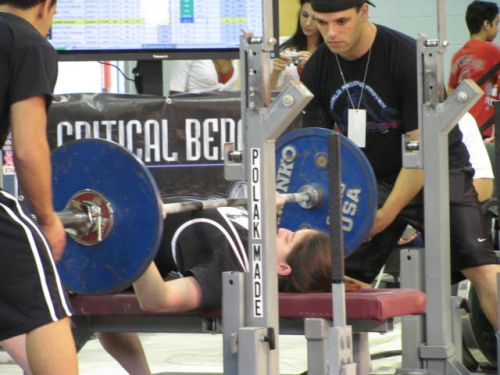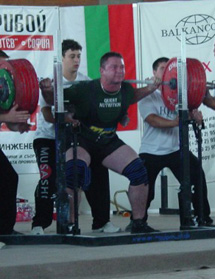Passive Restoring
by Mike Tuchscherer

We all know that training is stressful. And most of us understand that it's not the stress of training itself, but rather the recovery from that stress that produces the gains that we all work so hard to achieve.
Recent research is showing some very interesting trends. It seems that the more often a muscle is stressed, the greater the aggregate gain becomes. So do you want big gains quickly? Most of us do. Then research suggests that you train more frequently.
Of course, the common sense of application demands that there are acceptable limits to this. It is, after all, the recovery from this stress that leads to adaptation. And even among those who don't seek higher training frequencies, adequate recovery is still paramount and sometimes hard to come by. So no matter which camp you reside in, improving your rate of recovery is key to rapid and continued progress.
Before we just jump right in to how to improve recovery rate, let's discuss what recovery rate is. It may sound simple to some of you, but I just want to make sure we are all on the same page. Recovery Rate is the Rate at which a person Recovers. This means how fast they recover. Think of it like this... if you are on a 100m track and the start line is post workout (i.e. not recovered at all) and the finish line is fully recovered, your Recovery Rate is how fast you are moving from the start line to the finish line. So what we're trying to do with passive recovery methods is to improve the speed at which you travel from start to finish.
Passive Recovery Methods
There are literally dozens and dozens of methods and variations of passive recovery methods. I will only discuss a few here, but I'll narrow it down to the ones I have found most effective for me and my athletes.
The first method, and one that always makes folks cringe is the Ice Bath. It's pretty simple. Fill a bathtub with cold water and add ice to it until you get it around 50 degrees Fahrenheit. At that point, sit in the water for about 20 minutes. If you have an acute problem area (say, your wrists have some minor tendonitis), make sure to have that part submerged in the ice water. The ice obviously cools the body, but it also reduces inflammation and some information has shown it to strengthen the parasympathetic nervous system. This makes it a good general recovery tool as well as a specific one. And if you're concerned about the discomfort of the cold water... don't worry. After the first five minutes, you'll likely numb a little and it won't be so bad anymore!
Another method that has become popular lately is the contrast shower. Similar to an ice bath, you use temperature to encourage the body to speed the recovery process. To perform a contrast shower, you alternate between hot and cold water (being careful not to burn yourself). There are no set times for this but there are some typical guidelines. Generally, keep the water hot for about twice as long as you have cold water. Also, alternate for at least 5 minutes, but not more than 20 minutes. My favorite protocol has been to have hot water for 1 minute, then cold water for 30 seconds. Repeat this process 5 times. Contrast showers tend to work by encouraging circulation of blood, which helps accelerate recovery and remove metabolic byproducts.
There are many other ways to use hot-cold therapy. The alternation of hot packs and cold packs has been used to treat acute problem spots and may be a good method for you to use as well. The list goes on and on.
Massage also works well as a passive recovery tool. There are several kinds of massage and each have their own purposes. A simple relaxation massage can help balance your autonomic nervous system if you tend to be too far on the sympathetic side. Deep tissue massage can clearly be used to break up some scar tissues and adhesions in muscles, as well as facilitate removal of metabolic byproducts. And there is a whole host of methods in between, each with their own benefits. Just remember that if you are getting massage done for recovery purposes, it should be calm or rhythmic in nature. Vigorous massage is better suited for pre-activity rather than post-activity.

Soft tissue work has really become in vogue in the last couple of years and I'm not really one to diminish its importance. For significant problem areas, ART therapy seems to be the way to go. ART therapists are certified to perform Active Release Techniques that break up scar tissue and other muscular adhesions. This helps with flexibility, proper mechanics, diminished pain, and a laundry list of other symptoms as well. In addition, most ART therapists are also chiropractors, so they can help treat the skeleton as well, which is also important for an iron slinger.
But ART therapy isn't for everyone. Sometimes it can be expensive if your insurance doesn't cover it. Also, some people might live in an area where there aren't any ART therapists nearby. In these situations, you need to care for your soft tissue health on your own. Foam Rollers are quite popular lately and they do a very good job promoting general soft tissue health in the lower body and back. If you need something a little more aggressive, I recommend looking at a TheraCane or even simply rolling on a racquetball or a baseball. These tend to do well for more focused, "trigger point" style treatments.
I personally feel like stretching is an under-rated recovery tool. And besides, having muscles that are too tight can cause deficient motor patterns. That is to say, when you deadlift, you won't be able to execute the lift properly and this can result in injury. In addition, just general stretching of tight muscles can help you feel better, which in itself is a recovery technique. And don't worry - you won't ruin your stretch reflex. In fact, you may improve it by removing some neuromuscular inhibition as a result of your body being afraid of injuring itself. By improving your muscle length and general soft tissue health, your body is more likely to perform for you when you need it.
And then there's everyone's favorite - sleep. A good night's sleep is becoming more and more rare, but no less valuable to the hard training athlete. The common recommendation is 8 hours. I don't know that the hour quantity is as important as the times themselves. Go to bed early! Going to sleep before midnight seems to result in improved recovery over later sleep, regardless of the number of hours you're out. As with many things like this, individual results may vary.
As with many training choices, there are a lot of options out there when it comes to Passive Restoration. And when you use these methods in a training cycle is also important. Some need to be constant, others need to be cycled, but that's a topic for another time!
Mike Tuchscherer is the owner of Reactive Training Systems, a company dedicated to individualized physical training. The goal of RTS is to help you become a dominant force in your sport! Learn more by visiting www.ReactiveTrainingSystems.com.
Mike himself is an accomplished Powerlifter. He has over 12 years of experience training and researching the best training methods in the world. Mike has competed in raw and single ply competitions. He recently won the Gold medal representing the USA at the 2009 World Games; becoming the first American male to ever win this distinction. His best lifts in IPF competition are a 903 squat, a 644 bench press, an 826 deadlift, and a 2342 total in the 275 pound weight class.
More Articles By Mike Tuchscherer
Return to the Workout Articles Archive
|